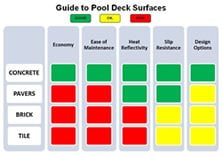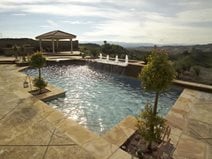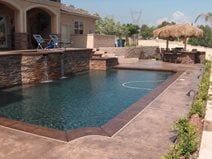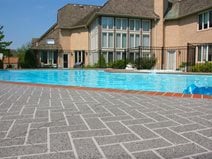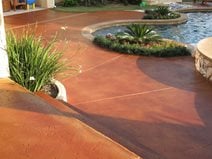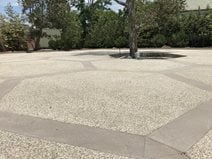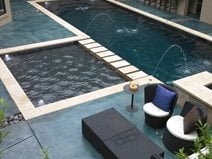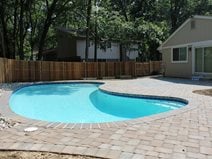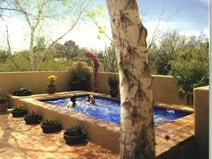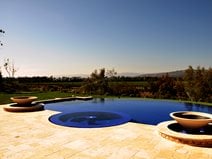- Concrete Pool Deck Info
- Pool Deck Pictures
- Pool Deck Design Ideas
- Stamped Concrete and Other Popular Pool Deck Surfaces
- Stamped Concrete
- Colored Concrete
- Exposed Aggregate
- Modern Concrete Pool Decks
- More Pool Deck Surfaces
- Compare Concrete Pool Decks
- Installing and Maintaining Concrete Pool Decks
- Pool Deck Cost
- Pool Coping
- Pool Deck Sealer
- Pool Deck Repair
- Pool Deck Resurfacing & Coatings
- Pool Deck Cleaning
- Other Resources
- Concrete Contractors: Find Concrete Products and Suppliers
- Design Ideas: Pool Deck Info
Pool Decking Options: What's the Best Pool Deck Material?
Learn why concrete is the best material to use around your pool and compare it to other optionsWhen comparing your pool decking options, it is important to consider the materials you want in your design. Decorative concrete can provide many of the looks you like, but in a cost-effective way. Plus, it combines design flexibility and beauty with strength and durability.
Find concrete pool deck contractors near me.
WHAT IS THE BEST MATERIAL TO USE AROUND A POOL?
When weighing which pool deck materials you want to use, consider factors such as budget, safety, maintenance, durability and how it fits your home and landscape. While concrete certainly isn't the only player in the game, it offers a number of advantages that other pool deck materials can't match, particularly when it comes to versatility.
We put concrete to the test in a face-off against some tough competition, including natural stone, pavers, brick and tile. Although all these materials have their pros and cons, we believe concrete is the clear winner in the following categories.
Slip Resistance
Because good traction is especially important on pool deck surfaces, slip resistance is a high priority. All of these pool deck materials can become slippery when wet, especially tile, but with concrete there are several ways to improve the surface traction without detracting from the decorative appearance. These include the use of broomed or exposed aggregate finishes, putting down a textured overlay, or mixing a clear plastic grit into the sealer before it's applied. (See Making Concrete Slip Resistant)
Heat Reflectivity
Compared to darker-colored brick and tile pool decks, which can become extremely hot to the touch after baking in the sun, concrete reflects solar radiation and is more comfortable on bare feet. There are also decorative toppings for concrete that can be used to significantly lower surface temperatures. (Get more information on overlays for cool pool decks.)
Affordability
While pool decks made of flagstone, pavers, or brick have great aesthetic appeal, they can be costly to install because of the labor required to place each unit individually. Many homeowners find it cheaper to pour concrete and apply a pattern than to haul and place paving units by hand. If you're on a tight budget, you can still achieve impressive results by mixing stamped concrete with fields of less-expensive plain concrete. Check out this guide to pool deck cost.
Design Options
Only decorative concrete gives you the ability to select any shape, size, color and surface treatment for your pool deck—from plain broom-finished concrete, to exposed aggregate or imprinted patterns that mimic tile, brick, or stone. You can also mix and match decorative treatments, such as combining stained concrete with a stenciled or imprinted border or enhancing a colored overlay with sawcut or engraved patterns. To learn more about the design possibilities, see Concrete Pool Deck Design Ideas.
Ease of Maintenance
All of the paving materials in our face-off are durable and have a long life span, but most of them require more maintenance than concrete. Bricks and paving units can shift over time, requiring releveling or replacement. The joints between paving units also need to be refilled with sand periodically to prevent weed growth. Poured concrete eliminates all these issues, and simply needs occasional cleaning and resealing to maintain its appearance. See this guide to maintaining and caring for exterior decorative concrete.
Keep in mind that pool decks have special performance requirements when compared with a typical patio. Pool decks need to resist constant exposure to water and harsh pool chemicals. They also need to be easy on bare feet, splinter-proof, and slip resistant. All these criteria can be met with a concrete pool deck.
FINISH OPTIONS FOR A DECORATIVE CONCRETE POOL DECK
Only decorative concrete gives you the ability to select any shape, size, color and surface treatment for your deck-from plain broom-finished concrete, to exposed aggregate, to imprinted patterns that mimic tile, brick, natural stone, and even wood. You can also mix and match decorative treatments, such as combining stained concrete with a stenciled or imprinted border or enhancing a colored overlay with sawcut or engraved patterns. You can design your concrete pool deck to blend in with your home's exterior facade and surrounding landscape, or make it the focal point of your backyard.
Stamped Concrete
To create pool decks that resemble natural slate, flagstone or brick, stamped concrete is the ideal choice. When colored with stains or dry-shake color hardeners, stamped concrete looks identical to real stone but is easier to install and maintain. Stamped concrete can also be used to complement other decorative surface treatments, such as exposed aggregate, broom finishes and borders. See Stamped Concrete Pool Decks.
Colored Concrete
The most popular methods for coloring concrete pool decks and other exterior concrete are chemical stains, integral color and dry-shake hardeners. Coloring usually goes hand in hand with stamped concrete, allowing you to precisely replicate the colors of natural stone or any other material. For pool decks, lighter colors are especially popular because they reflect UV rays and keep the surface cooler. Learn more about your coloring options for concrete pool decks.
Stenciled Concrete
Stenciling a concrete pool deck can be a great alternative to decorative stamping while permitting similar design flexibility. Instead of rubber stamps, stenciling uses disposable paper stencils to impart brick or stone patterns in fresh concrete. By applying a dry-shake color hardener or stain to the exposed concrete before stencil removal, you'll get the appearance of individual stones or bricks that have been mortared together. Stencils for concrete come in a wide array of patterns, ranging from running-bond brick to stone, slate and tile. For more information, see Concrete Stencils.
Rock-Salt Finished Concrete
A rock salt finish is a low-cost, easy method for adding subtle texture and slip resistance to plain or colored concrete pool decks. It’s created by pressing grains of rock salt into freshly placed concrete with a float or roller and then washing them away. The result is a beautiful speckled pattern on the concrete surface, similar to the appearance of slightly pitted, weathered rock. Read about the various decorative options for rock salt finishes.
Exposed Aggregate
Exposing the aggregate in concrete produces a pebble-like finish that is especially well-suited for pool deck surfaces because it's highly slip resistant. The finish can also be very attractive when youuse decorative aggregate in an assortment of colors and sizes. A popular technique is to combine exposed aggregate finishes with areas of smooth concrete to create interesting contrast. See Exposed Aggregate Pool Decks.
Brushed or Broom Finish
A brushed or broom finish will add a slip-resistant texture to your pool deck. A brushed finish is achieved by running a broom over a freshly poured or newly coated concrete surface. Although this is more of a basic design option, it does allow dyes and stains to be successfully applied to your surface. Read more about brushed or broom finishes.
OTHER POOL DECK SURFACE OPTIONS
Concrete Pavers
Like poured-in-place concrete, precast concrete pavers are a great option for pool decks because they are durable, slip resistant and can provide the look of natural stone or brick. Concrete pavers also come in a wide array of colors, shapes and sizes, permitting you to create design schemes that complement your pool’s shape and style. See below to learn more about concrete paver benefits and installation.
Wood Decks
Wood decking isn't usually practical for in-ground pools because it doesn't stand up well to harsh pool chemicals and moisture. Tropical hardwoods like ipe or composite products can be used, but are often too expensive. If you prefer the look of wood, you can stamp and color concrete to look like wood planking. It will last longer, be easier to maintain, and be less vulnerable to damage from chemicals, water and UV rays. (See Concrete Pool Deck Replicates Wood Planking.)
Brick and Tile
Brick and ceramic glazed tile have been long been used for pool deck surfaces. Tile is popular for use along pool copings due to its longevity and finished appearance. Brick is also an attractive, durable material for use along pool borders and pool decks. However, in climates where freezing occurs, "antique" bricks are to be avoided as this material is known to absorb water and spall or crack during the frozen winter months. Brick and tile can also be slippery, hot surfaces. Another problem with these materials is their steep cost and labor-intensive installation.
Travertine
A travertine pool deck has a luxurious, Mediterranean look. These stones are installed like pavers over a base of sand and gravel. Concrete can be used to create a similar look at a much lower cost using stamps or special coatings.
Flagstone
Also known as "bluestone," flagstone offers a sleek and traditional look. However, very sunny sites will often heat flagstone to uncomfortable levels, particularly for young children. Learn how stamped concrete can recreate the look of flagstone.
Granite
Pool decks constructed with granite offer the rustic look of stone and great durability.
RELATED:
6 Types of Driveways

